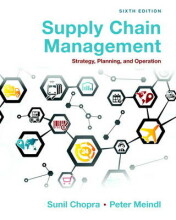Try our study magic for free
Summary: Supply Chain Management Strategy, Planning, And Operation | 9780133800203 | Sunil Chopra, et al
- This + 400k other summaries
- A unique study and practice tool
- Never study anything twice again
- Get the grades you hope for
- 100% sure, 100% understanding
a PDF, study it super fast
- No sign up, email or credit card needed!
- AI makes unlimited flashcards
- Get unlimited quizzes and tests
- Ask AI anything
- No sign up, email or credit card needed!
- Have and keep perfect overview
- Make flashcards, notes and mind maps
- Review, test and score!
Read the summary and the most important questions on Supply Chain Management Strategy, Planning, and Operation | 9780133800203 | Sunil Chopra; Peter Meindl
-
3.5 Inventory
This is a preview. There are 3 more flashcards available for chapter 3.5
Show more cards here -
Why does inventory exist?
because of a mismatch between supply and demand, most of the time an intentional mismatch -> more economical to manufacture in large lots and then store for future sales -
What is Cycle Inventory?
average amount of inventory used to satisfy demand between receipts of supplier shipments -
What is Seasonal Inventory?
Built up inventory to counter predictable seasonal variability in demand. It is build up in periods with low demand and stored for periods with high demand. -
4 Designing Distribution Networks and Applications to Online Sales
-
4.2 Factors influencing distribution network design
This is a preview. There are 2 more flashcards available for chapter 4.2
Show more cards here -
Along which two dimensions should the performance of a distribution network be evaluated?
- value provided to the customer
- Cost of meeting customer needs
-
Give 4 supply chain costs that are affected when changing the distribution network design
- Inventories
- Transportation
- Facilities and handling
- Information
-
What are the Total logistics costs?
the sum of the inventory, transportation and facility costs for a supply chain network. -
4.3 Design options for a distribution network
This is a preview. There are 1 more flashcards available for chapter 4.3
Show more cards here -
Which two key decisions should managers make when designing a distribution network?
- Will product be delivered to the customer location or picked up from prearranged site?
- Will product flow through an intermediary location?
-
4.5 Distribution Networks in Practise
-
Give 4 things to take into account when managing a distribution network
- The ownership structure of the distribution network can have as big an impact as the type of distribution network
- It is important to have adaptable distribution networks
- Products price, commoditization, and criticality affect the type of distribution system preffered by customers
- Integrate the Internet with the existing physical network
-
5 Network Design in the Supply Chain
-
5.2 Factors influencing network design decisions
This is a preview. There are 2 more flashcards available for chapter 5.2
Show more cards here -
What are macroeconomic factors that influence network design decisions in supply chains?
Things like taxes, tariffs, exchange rates and shipping costs that are not internal to an individual firm. -
What are tariffs and tax incentives?
Tariffs refers to any duties that must be paid when products or equipment are moved across international, state or city borders.
Tax incentives are a reduction in tariffs or taxes that countries, states and cities often provide to encourage firms to move to their specific areas.
- Higher grades + faster learning
- Never study anything twice
- 100% sure, 100% understanding
Topics related to Summary: Supply Chain Management Strategy, Planning, And Operation
-
Network Design in the Supply Chain
-
Demand Forecasting in a Supply Chain
-
Managing Economies of Scale in a Supply Chain
-
Managing Uncertainty in a Supply Chain
-
Determining the Optimal Level of Product Availability - Factors Affecting Optimal Level of Product Availability
-
Transportation in a Supply Chain - Design options for a transportation network
-
Transportation in a Supply Chain - Trade-Offs in transportation Design
-
Transportation in a Supply Chain - Tailored Transportation
-
Sourcing Decisions in a Supply Chain - In-House or Outsource
-
Sourcing Decisions in a Supply Chain - Total cost of ownership
-
Sourcing Decisions in a Supply Chain - Sharing risk and reward in the supply chain































